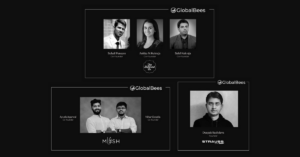If you ask any founder of a rapidly scaling startup what their company is focused on, one key ingredient often gets overlooked in scaling discussions: culture
One thing is undeniable: quantifying employee sentiment can provide every startup with the tools it needs to ensure culture preservation as it scales
Scaling beyond 100 employees means you’re doing something right. The goal is to avoid the cultural pitfalls that can come with it
There’s a famous quote by management consultant and author, Peter Drucker that goes, “Culture eats strategy for breakfast”. That’s not to say strategy isn’t important, but without a strong culture, even the best-laid plans can backfire.
If you ask any founder of a rapidly scaling startup what their company is focused on, you’ll likely get answers ranging from product to customer experience to financial health, and so on. All of these are critical areas to focus on, but one key ingredient often gets overlooked in scaling discussions: culture.
Is culture even important when scaling if no one is talking about it? The answer is a resounding yes, because, aside from a good coffee machine, which I’ve been told is essential for talent retention, there’s a quantifiable link between employee happiness and retention. (Not to undermine the impact of great coffee, of course).
The last thing any startup wants as they scale is to start losing great talent to poor culture, but that’s exactly the situation an ad-tech founder found himself in. While they added 800 new employees, 40% of them left, including older workers. Culture wasn’t an oft-discussed topic, either within the company or the ecosystem at large. Having to deal with the sudden attrition was an eye-opener for him and not in the most pleasant way.
Aside from retention, culture can be a powerful competitive advantage because it is difficult to replicate implicit habits and mindsets.
In his journey of interviewing multiple product managers, the Chief People Officer of a major ecommerce company in its hyper-growth phase realised this. He noticed that the majority of interviewees began with what the company needed to accomplish. This was not what he was used to at his previous job, where a product manager would always start with a customer problem and then consider how solving it would benefit the company — they did it because everyone else did it. He realised then that, while competitors could replicate everything else, the unestablished norms in his company that were driven by culture would be difficult to replicate.
While creating and maintaining a positive culture is relatively easier in the early stages due to smaller team sizes, cracks begin to appear when the organisation rapidly grows and one culture splits into many.
We recently conducted a survey of 50,000 employees from 150 Indian startups to learn what makes them happy and fulfilled at work, what their organisations do well, and what can be improved. This survey, which measured the startups’ eNPS (employee Net Promoter Score®) across multiple dimensions, provided us with an unprecedented amount of data (over 2.5 Mn data points! ), as well as a number of eye-opening insights.
For one, the range of eNPS across the ecosystem is extremely wide, ranging from as low as -8 to +97!
But it’s the reason for this disparity that is extremely telling.
The Inflexion Point
We’ve noticed that when an organisation reaches 100 employees, cultural issues emerge and only worsen with scale if not addressed. Companies with 50 or fewer employees had an average eNPS of 51. However, as companies grow in size beyond 100 employees, the eNPS steadily declines. Organisations with over 1000 employees had an average eNPS of 36.
Here’s why founders should keep track of their employees’ feelings as they grow. The attrition rate among startups in the bottom quartile of eNPS is 40%. Detractors outnumber promoters in companies with a negative eNPS, and attrition among detractors is 43%. To put things in perspective, the average ecosystem attrition rate is 28%.
This isn’t to say it’s all bad news. Plenty of startups have managed to grow exponentially and achieve high eNPS. Meesho, with over 1700 employees, has created a stand-out culture by improving organisational policies, developing managers, and addressing problems that were making individual teams unhappy. They rank in the top quartile of eNPS in the ecosystem.
Having this inflexion point on your radar will be critical to your scaling journey. Measuring and analysing your culture can reveal exactly what needs to be fixed across policies, teams, and managers, as well as serve as an early warning sign of culture erosion. We’ve seen companies grow in size without diluting their eNPS by focusing on developing their managers and developing the right policies.
While we delve deeper into these numbers, one thing is undeniable: quantifying employee sentiment can provide every startup with the tools it needs to ensure culture preservation as it scales.
Scaling beyond 100 employees means you’re doing something right. The goal is to avoid the cultural pitfalls that can come with it.
So if you’re a founder of a rapidly growing startup, I hope you’ve already started your journey towards building a great organisation, because the numbers don’t lie.



![Read more about the article [YS Learn] Five steps you can take to ensure you rise up the career ladder](https://blog.digitalsevaa.com/wp-content/uploads/2021/03/promotion-1615181085833-300x150.png)






